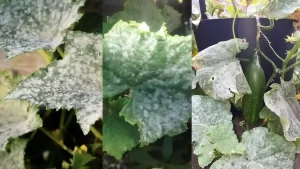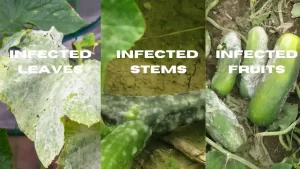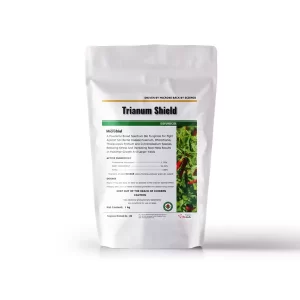Powdery Mildew easily affects cucumber plants, with two pathogens, Erysiphe cichoracearum and Podosphaera xanthii, causing this fungal disease. If not promptly addressed, it can result in reduced yield and significant damage.
Fortunately, natural solutions such as Trichoderma Harzianum from Trianum Shield are the best fungicide in cucumber powdery mildew treatment. In this blog, we will discuss the causes and effects of powdery mildew cucumber plants, as well as how to figure out why my cucumber leaves are turning white?

As a fungal disease, Powdery mildew of cucumber affects the leaves, stems and fruit of plants. On the surface of the damaged plant sections, white, the spores can be seen, which is how you can recognise it.
Powdery mildew cucumber can cause leaf yellowing, stunted growth, and lower yields. It thrives in humid or damp conditions, and you can prevent or control it by providing proper air circulation, avoiding overhead watering, and using fungicides.
When powdery mildew cucumber attacks suddenly, the foliage of your cucumber and squash appears as if someone has dusted it with baby powder. Initially, cucumber powdery mildew (Podosphaera xanthii) may go unnoticed with only a few infected leaves. However, the white spots and ash-like coating will cover the plant’s leaves, fruits, and branches, making it easy to detect powdery mildew on cucumbers. Leaf yellowing, stunted growth, and lower yields are all potential effects of this disease.
The illness is most noticeable on both sides of the leaf, where the distinctive white powder typically gives place to yellowish patches when removed. This disease impairs the plant’s ability to breathe and lowers its ability to photosynthesize. In truth, the leaves end up withering and the plant’s capacity for reproduction is harmed, which prevents the remainder of the fruit from growing to its full potential.
Despite not directly affecting the fruit, powdery mildew cucumber causes infected foliage to yellow, become brown, and eventually die. However, there are a number of cucumber powdery mildew treatment procedures to stop the wind from carrying the cucumber powdery mildew to the other plants.

It is still the most preferred way to treat powdery mildew cucumber issues. You can Mix baking soda and water and spray them all over the cucumbers. Baking soda is quite effective in controlling powdery mildew on cucumber attack. It is also very safe to use baking soda on plants. The primary issue while using this product is that it might not be as effective as chemical fungicides, and you will need to keep on applying it in a very frequent gap.
Neem oil is a natural oil and has been effective against many fungal diseases as well as effective against powdery mildew on cucumbers. Because it can disrupt the fungal cell membrane easily, it helps you to kill the fungus. Additionally, it is safe to use on plants but always keep in mind it is dangerous against a few non-target organisms.
 Trichoderma harzianum is a fungicide for powdery mildew biological control. It can colonize the roots and form a protective layer around them when applied to the soil around the plant. By doing this, you may be able to stop the fungus’ growth and keep the plant from becoming infected.
Trichoderma harzianum is a fungicide for powdery mildew biological control. It can colonize the roots and form a protective layer around them when applied to the soil around the plant. By doing this, you may be able to stop the fungus’ growth and keep the plant from becoming infected.
With antifungal qualities, Trichoderma harzianum is capable of producing enzymes that decompose organic soil material, resulting in better soil structure and fertility. This can be beneficial for the overall health and growth of plants. Luckily, here we got Trianum Shield, the best fungicide for cucumbers with the active ingredient Trichoderma harzianum.
While the biofungicide is highly effective in powdery mildew biological control, it is recommended to follow proper application guidelines and integrate it with other cultural practices for optimal disease management in cucumber powdery mildew.
1.Elad, Yigal & Kirshner, B. & Yehuda, Nat & Sztejnberg, A.. (1998). Management of powdery mildew and gray mold of cucumber by Trichoderma harzianum T39 and Ampelomyces quisqualis AQ10. BioControl. 43. 241-251. 10.1023/A:1009919417481.
2.Sarhan, E.A.D., Abd-Elsyed, M.H.F. & Ebrahiem, A.M.Y. Biological control of cucumber powdery mildew (Podosphaera xanthii) (Castagne) under greenhouse conditions. Egypt J Biol Pest Control 30, 65 (2020).
Cutworms in gardens are a major menace to all..
As a farmer,I inspect my fields daily to monitor..
It all started with a worried farmer named Mr...

Leave a Reply